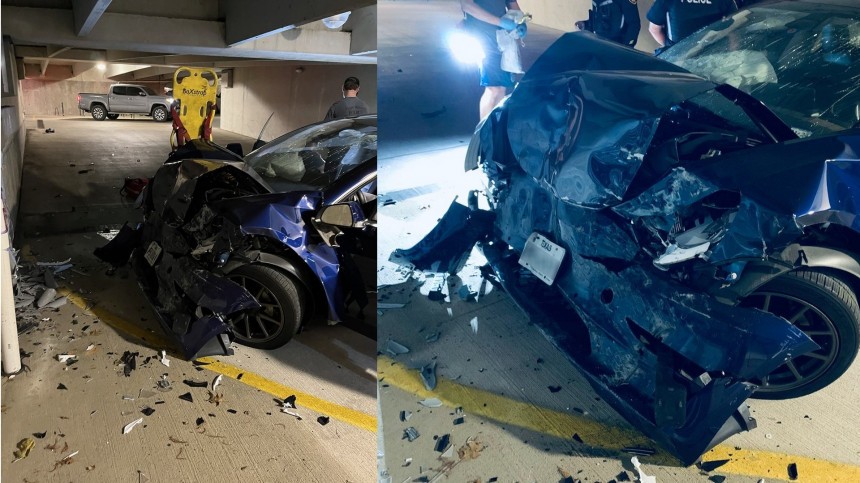New information received by the NHTSA shows that sudden unintended acceleration events with Tesla EVs were real and not driver errors. The report explains in detail what caused the cars to accelerate even when the accelerator pedal was not pressed. It also offers recommendations to solve this issue once and for all.
Update: Since autoevolution broke the story, Tesla hacker Jason Hughes has offered his own side of the story, and I believe you should read it.
For quite some time, Tesla electric vehicles have been accused by drivers of accelerating out of control without anyone touching the accelerator pedal. Still, investigations have concluded that almost every single case was caused by the drivers inadvertently pressing the accelerator pedal instead of the brake. Chinese Tesla owners have got so far that they installed cameras in the foot area of their cars to prove they did not press the accelerator should a sudden unintended acceleration (SUA) event occur.
Safety bodies in several countries opened investigations into these crashes. Many were closed after Tesla provided evidence that the accelerator pedal was pressed all the way down in all these cases. The NHTSA also investigated Tesla SUA reports, but in January 2021, the Office of Defects Investigation (ODI) denied the petition filed a year earlier.
According to the ODI Resume for the DP 20-001 investigation, no evidence has been identified that would support opening a defect investigation into SUA in the subject vehicles. In every instance in which event data was available for review by ODI, the evidence showed that SUA crashes were caused by pedal misapplication.
However, on June 29, 2023, ODI received a new petition requesting a reevaluation of the decision to deny DP20-001. The document explains that intermittent high electrical current demands on the vehicles' 12VDC systems may have caused some or all of the incidents examined by ODI in DP20-001. The petitioner based their information on a review of open-source research analyzing the Tesla Model 3 inverter design.
If you were wondering what causes the negative spikes in the low-voltage system, the petition (attached below) is very detailed in engineering data. Apparently, the steering assist system uses a very high current motor powered by the 12-volt system. Because Teslas are heavy vehicles, the driver assist motor needs in excess of 100 amps to turn the wheels when the car is stationary. This causes the 12-volt system to drop voltage to near zero volts for several hundred microseconds.
This in itself does not cause sudden unintended acceleration. However, if a recalibration is initiated during this interval, then an incorrect calibration voltage will be produced that is very close to zero volts. Based on the researcher's findings, it will last until another ADC calibration is performed, which may be minutes later. Once the calibration is performed with faulty data, it can cause a spike equivalent to pressing the accelerator pedal all the way down.
What's worse is that the incorrectly increased sensor signals will be sent via the CAN bus to the vehicle logs, causing Tesla and NHTSA to conclude that the driver caused the sudden increase in torque by stepping on the accelerator pedal. But in this case, the sudden acceleration was caused not by the driver stepping on the accelerator pedal but by a random superposition of a negative-going voltage spike (which is about 100 microseconds long), and the sampling time of the analog-to-digital converter (which is about 10 microseconds long). This random superposition explains the low occurrence rate of sudden acceleration in Tesla vehicles.
The study also offers two solutions to this problem. The first involves adding a second 12-volt supply line with its own battery and DC/DC converter. This should be used only for powering the APP sensors and the ADCs to provide clean power to these functions. The second solution is modifying the calibration routine software by testing the calibration voltage before using it. The latter is by far easier and cheaper to implement in existing vehicles, as it only requires a software update.
According to the petition, all Tesla vehicles are affected, although the Model S and Model X use a slightly different DSP controller chip. NHTSA investigation mentions that 1.8 million vehicles are part of this new investigation. The findings represent a welcome relief for those who reported SUA events and were told they caused them. Unfortunately, for some people might be too late.
For quite some time, Tesla electric vehicles have been accused by drivers of accelerating out of control without anyone touching the accelerator pedal. Still, investigations have concluded that almost every single case was caused by the drivers inadvertently pressing the accelerator pedal instead of the brake. Chinese Tesla owners have got so far that they installed cameras in the foot area of their cars to prove they did not press the accelerator should a sudden unintended acceleration (SUA) event occur.
Safety bodies in several countries opened investigations into these crashes. Many were closed after Tesla provided evidence that the accelerator pedal was pressed all the way down in all these cases. The NHTSA also investigated Tesla SUA reports, but in January 2021, the Office of Defects Investigation (ODI) denied the petition filed a year earlier.
According to the ODI Resume for the DP 20-001 investigation, no evidence has been identified that would support opening a defect investigation into SUA in the subject vehicles. In every instance in which event data was available for review by ODI, the evidence showed that SUA crashes were caused by pedal misapplication.
However, on June 29, 2023, ODI received a new petition requesting a reevaluation of the decision to deny DP20-001. The document explains that intermittent high electrical current demands on the vehicles' 12VDC systems may have caused some or all of the incidents examined by ODI in DP20-001. The petitioner based their information on a review of open-source research analyzing the Tesla Model 3 inverter design.
ODI petition: All Teslas are prone to sudden unintended acceleration (SUA)
Based on this, a faulty inverter design creates conditions where negative spikes in Tesla's low-voltage system can be interpreted as a full acceleration command even though the driver did not touch the accelerator. This is possible because the inverter uses a voltage reference derived from the 12-volt system to calibrate the accelerator pedal position (APP) sensor. It also explains why the logs show the accelerator was pressed all the way down, even though drivers claimed it didn't touch the accelerator.If you were wondering what causes the negative spikes in the low-voltage system, the petition (attached below) is very detailed in engineering data. Apparently, the steering assist system uses a very high current motor powered by the 12-volt system. Because Teslas are heavy vehicles, the driver assist motor needs in excess of 100 amps to turn the wheels when the car is stationary. This causes the 12-volt system to drop voltage to near zero volts for several hundred microseconds.
What's worse is that the incorrectly increased sensor signals will be sent via the CAN bus to the vehicle logs, causing Tesla and NHTSA to conclude that the driver caused the sudden increase in torque by stepping on the accelerator pedal. But in this case, the sudden acceleration was caused not by the driver stepping on the accelerator pedal but by a random superposition of a negative-going voltage spike (which is about 100 microseconds long), and the sampling time of the analog-to-digital converter (which is about 10 microseconds long). This random superposition explains the low occurrence rate of sudden acceleration in Tesla vehicles.
Tesla could solve the problem easily
The researchers went even further and managed to verify their theory by deliberately inputting the wrong calibration voltage into the inverter. When they entered 0,28 volts or less instead of the expected 1.65 volts (which can happen when the 12-volt supply dips briefly to 2.14 volts), the APP sensor would read values equivalent to flooring the accelerator pedal. This causes sudden unintended acceleration without the driver pressing on the accelerator pedal.The study also offers two solutions to this problem. The first involves adding a second 12-volt supply line with its own battery and DC/DC converter. This should be used only for powering the APP sensors and the ADCs to provide clean power to these functions. The second solution is modifying the calibration routine software by testing the calibration voltage before using it. The latter is by far easier and cheaper to implement in existing vehicles, as it only requires a software update.
According to the petition, all Tesla vehicles are affected, although the Model S and Model X use a slightly different DSP controller chip. NHTSA investigation mentions that 1.8 million vehicles are part of this new investigation. The findings represent a welcome relief for those who reported SUA events and were told they caused them. Unfortunately, for some people might be too late.


























